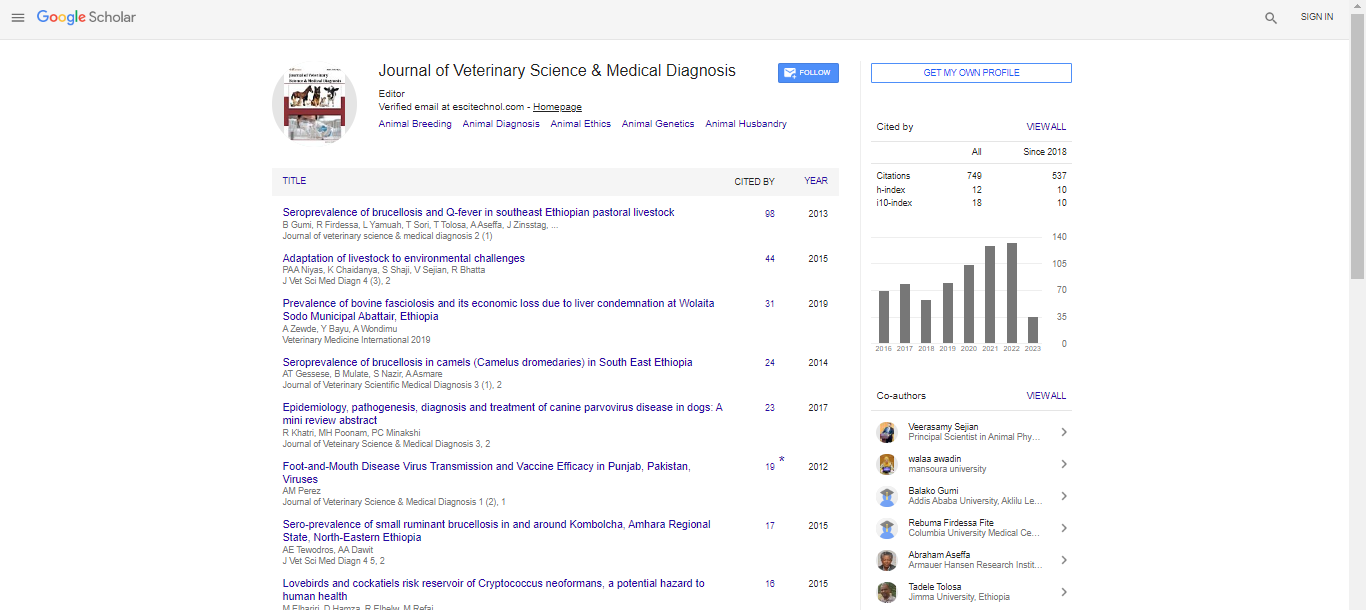Commentary, J Vet Sci Med Diagn Vol: 13 Issue: 2
Implications for Disease Management and Control in Animals
Geetha Sharma*
Department of Veterinary and Animal Sciences, G. B. Pant University of Agriculture and Technology, Pantnagar, India
- *Corresponding Author:
- Geetha Sharma
Department of Veterinary and Animal Sciences,
G. B. Pant University of Agriculture and Technology,
Pantnagar,
India;
E-mail: geetha@yahoo.ac.in
Received date: 13 March, 2024, Manuscript No. JVSMD-24-154229;
Editor assigned date: 15 March, 2024, PreQC No. JVSMD-24-154229 (PQ);
Reviewed date: 29 March, 2024, QC No. JVSMD-24-154229;
Revised date: 09 April, 2024, Manuscript No. JVSMD-24-154229 (R);
Published date: 16 April, 2024, DOI: 10.4172/2325-9590.1000091
Citation: Sharma G (2024) Implications for Disease Management and Control in Animals. J Vet Sci Med Diagn 13:2.
Description
Effective disease management and control are important for ensuring the health and productivity of animals in both agriculture and veterinary care. Diseases in animals can have profound impacts, ranging from loss of livestock productivity to the spread of zoonotic diseases that can affect human populations. As such, disease management strategies must be comprehensive, involving prevention, early detection, treatment and containment. These strategies must also consider the various challenges posed by changing environmental conditions, emerging diseases and the increasing interconnection between human, animal and environmental health.
One of the primary methods of disease management in animals is prevention. Vaccination plays a vital role in controlling infectious diseases in livestock, companion animals and wildlife. Vaccines can reduce the incidence of common diseases like foot-and-mouth disease, rabies and avian influenza and are often the first line of defence against viral, bacterial and parasitic pathogens. In addition to vaccination, biosecurity measures are essential for preventing disease outbreaks. These include practices such as quarantine for new animals, maintaining clean and sanitized facilities, controlling animal movement and managing pest and vector populations. Early detection of disease is important for effective disease control.
Advances in veterinary diagnostics, such as PCR-based tests, serological assays and other molecular tools, have improved the ability to detect pathogens quickly and accurately. Early diagnosis allows for prompt intervention, preventing the spread of infection to other animals and minimizing the impact on livestock production. Disease surveillance programs also play an important role in monitoring animal health on a broader scale. These programs, which may involve periodic health checks or reporting systems for farmers and veterinarians, help detect outbreaks early and assess the geographic spread of diseases. Surveillance programs can be particularly effective for diseases with potential for rapid transmission.
Additionally, the development of Antimicrobial Resistance (AMR) in animals is an on-going challenge, African swine fever or bovine tuberculosis, can lead to devastating economic losses in farming industries if not promptly contained. The overuse of antibiotics and other medications in livestock farming, often to promote growth or prevent disease in crowded conditions, can lead to resistant strains of bacteria that are difficult to treat. These resistant bacteria can be transmitted to humans through food or direct contact with animals, compounding public health concerns.
The "One Health" approach, which recognizes the interconnectedness of human, animal and environmental health, has emerged as an important framework for managing and controlling diseases. This integrated approach emphasizes collaboration between veterinary, medical, environmental and agricultural professionals to monitor, prevent and control diseases. By sharing data and resources, such collaboration helps improve early warning systems, enhance disease surveillance and create more effective strategies for disease control.
In conclusion, disease management and control in animals are important for protecting both animal and public health. Effective strategies must combine prevention through vaccination and biosecurity, early detection through advanced diagnostics and ongoing monitoring through disease surveillance programs. However, the challenges posed by emerging diseases, antimicrobial resistance and ethical concerns require innovative and collaborative solutions. As the world continues to face new health threats, a comprehensive approach to animal disease management such as the One Health framework will be essential for ensuring the health and safety of both animals and humans.
 Spanish
Spanish  Chinese
Chinese  Russian
Russian  German
German  French
French  Japanese
Japanese  Portuguese
Portuguese  Hindi
Hindi 
